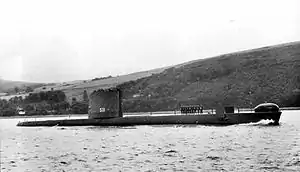HMS Orpheus (S11)
HMS Orpheus was an Oberon-class submarine of the Royal Navy.
 HMS Orpheus | |
| History | |
|---|---|
| Name: | HMS Orpheus |
| Builder: | Vickers, Barrow-in-Furness |
| Laid down: | 16 April 1959 |
| Launched: | 17 November 1959 |
| Commissioned: | 25 November 1960 |
| Identification: | pennant number: S11 |
| Fate: | Scrapped, 1994 |
| General characteristics as designed | |
| Class and type: | Oberon-class submarine |
| Displacement: |
|
| Length: |
|
| Beam: | 26.5 feet (8.1 m) |
| Draught: | 18 feet (5.5 m) |
| Propulsion: |
|
| Speed: |
|
| Complement: | 68 (6 officers, 62 enlisted) |
| Sensors and processing systems: |
|
| Armament: |
|
Design and construction
The Oberon class was a direct follow on of the Porpoise-class, with the same dimensions and external design, but updates to equipment and internal fittings, and a higher grade of steel used for fabrication of the pressure hull.[1]
As designed for British service, the Oberon-class submarines were 241 feet (73 m) in length between perpendiculars and 295.2 feet (90.0 m) in length overall, with a beam of 26.5 feet (8.1 m), and a draught of 18 feet (5.5 m).[2] Displacement was 1,610 tons standard, 2,030 tons full load when surfaced, and 2,410 tons full load when submerged.[2] Propulsion machinery consisted of 2 Admiralty Standard Range 16 VMS diesel generators, and two 3,000 shaft horsepower (2,200 kW) electric motors, each driving a 7-foot diameter (2.1 m) 3-bladed propeller at up to 400 rpm.[2] Top speed was 17 knots (31 km/h; 20 mph) when submerged, and 12 knots (22 km/h; 14 mph) on the surface.[2] Eight 21-inch (530 mm) diameter torpedo tubes were fitted (six facing forward, two aft), with a total payload of 24 torpedoes.[2] The boats were fitted with Type 186 and Type 187 sonars, and an I-band surface search radar.[2] The standard complement was 68: 6 officers, 62 sailors.[2] Unlike other members of the class, which had a fin made from glass fibre-reinforced plastic, the fin of Orpheus was made of aluminium alloy.[2]
Orpheus was laid down by Vickers-Armstrongs on 16 April 1959, and launched on 17 November 1959.[2] The boat was commissioned into the Royal Navy on 25 November 1960.[2]
Operational history
In mid-1964, Orpheus joined the 3rd Submarine Flotilla based at Faslane. In Juny 1965 she carried out submarine escape trials off Malta, with a record 500 feet (150 m) free ascent made. Other duties including training Canadian and Australian crews for Oberon-class submarines that were being built for those countries.[3] On 15 February 1967 Orpheus collided with sister-ship Opportune in poor weather and darkness off Portsmouth Harbour. Orpheus's commanding officer was reprimanded at the resultant court martial.[4]
Orpheus attended the 1977 Silver Jubilee Fleet Review off Spithead when she was part of the Submarine Flotilla.[5]
Decommissioning and fate
She was in harbour service in 1987 and was broken up in 1994.
References
- Chant, Christopher (2005). Submarine Warfare Today: The World's Deadliest Underwater Weapons Systems. Wigston: Silverdale Books. p. . ISBN 1-84509-158-2. OCLC 156749009.
- Moore, John, ed. (1977). Jane's Fighting Ships 1977-78. Jane's Fighting Ships (80th ed.). London: Jane's Yearbooks. p. 490. ISBN 0531032779. OCLC 18207174.
- "Crew 'Escaped' From 500 Feet". Navy News. October 1966. p. 3. Retrieved 17 August 2018.
- "Collision—decisions of courts martial". Navy News. May 1967. p. 6. Retrieved 18 August 2018.
- Official Souvenir Programme, 1977. Silver Jubilee Fleet Review, HMSO
Publications
- Colledge, J. J.; Warlow, Ben (2006) [1969]. Ships of the Royal Navy: The Complete Record of all Fighting Ships of the Royal Navy (Rev. ed.). London: Chatham Publishing. ISBN 978-1-86176-281-8.